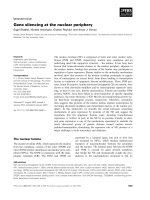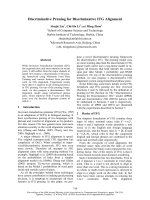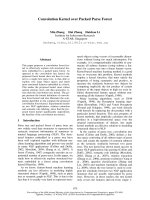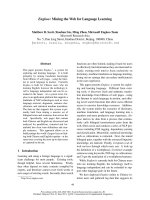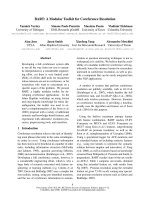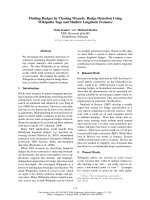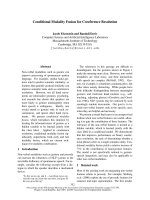Báo cáo khoa học: "Finding non-local dependencies: beyond pattern matching" pdf
Bạn đang xem bản rút gọn của tài liệu. Xem và tải ngay bản đầy đủ của tài liệu tại đây (71.29 KB, 7 trang )
Finding non-local dependencies: beyond pattern matching
Valentin Jijkoun
Language and Inference Technology Group,
ILLC, University of Amsterdam
Abstract
We describe an algorithm for recover-
ing non-local dependencies in syntac-
tic dependency structures. The pattern-
matching approach proposed by John-
son (2002) for a similar task for phrase
structure trees is extended with machine
learning techniques. The algorithm is es-
sentially a classifier that predicts a non-
local dependency given a connected frag-
ment of a dependency structure and a
set of structural features for this frag-
ment. Evaluating the algorithm on the
Penn Treebank shows an improvement of
both precision and recall, compared to the
results presented in (Johnson, 2002).
1 Introduction
Non-local dependencies (also called long-distance,
long-range or unbounded) appear in many fre-
quent linguistic phenomena, such as passive, WH-
movement, control and raising etc. Although much
current research in natural language parsing focuses
on extracting local syntactic relations from text, non-
local dependencies have recently started to attract
more attention. In (Clark et al., 2002) long-range
dependencies are included in parser’s probabilistic
model, while Johnson (2002) presents a method for
recovering non-local dependencies after parsing has
been performed.
More specifically, Johnson (2002) describes a
pattern-matching algorithm for inserting empty
nodes and identifying their antecedents in phrase
structure trees or, to put it differently, for recover-
ing non-local dependencies. From a training corpus
with annotated empty nodes Johnson’s algorithm
first extracts those local fragments of phrase trees
which connect empty nodes with their antecedents,
thus “licensing” corresponding non-local dependen-
cies. Next, the extracted tree fragments are used as
patterns to match against previously unseen phrase
structure trees: when a pattern is matched, the algo-
rithm introduces a corresponding non-local depen-
dency, inserting an empty node and (possibly) co-
indexing it with a suitable antecedent.
In (Johnson, 2002) the author notes that the
biggest weakness of the algorithm seems to be that
it fails to robustly distinguish co-indexed and free
empty nodes and it is lexicalization that may be
needed to solve this problem. Moreover, the author
suggests that the algorithm may suffer from over-
learning, and using more abstract “skeletal” patterns
may be helpful to avoid this.
In an attempt to overcome these problems we de-
veloped a similar approach using dependency struc-
tures rather than phrase structure trees, which, more-
over, extends bare pattern matching with machine
learning techniques. A different definition of pat-
tern allows us to significantly reduce the number
of patterns extracted from the same corpus. More-
over, the patterns we obtain are quite general and in
most cases directly correspond to specific linguistic
phenomena. This helps us to understand what in-
formation about syntactic structure is important for
the recovery of non-local dependencies and in which
cases lexicalization (or even semantic analysis) is
required. On the other hand, using these simpli-
fied patterns, we may loose some structural infor-
mation important for recovery of non-local depen-
dencies. To avoid this, we associate patterns with
certain structural features and use statistical classifi-
NP
NP
the asbestos
VP
found NP
*
PP
in NP
schools
(a) The Penn Treebank format
asbestos
the
MOD
found
S-OBJ
in
PP
schools
NP-OBJ
NP-OBJ
(b) Derived dependency structure
Figure 1: Past participle (reduced relative clause).
cation methods on top of pattern matching.
The evaluation of our algorithm on data automat-
ically derived from the Penn Treebank shows an in-
crease in both precision and recall in recovery of
non-local dependencies by approximately 10% over
the results reported in (Johnson, 2002). However,
additional work remains to be done for our algorithm
to perform well on the output of a parser.
2 From the Penn Treebank to a
dependency treebank
This section describes the corpus of dependency
structures that we used to evaluate our algorithm.
The corpus was automatically derived from the Penn
Treebank II corpus (Marcus et al., 1993), by means
of the script chunklink.pl (Buchholz, 2002)
that we modified to fit our purposes. The script uses
a sort of head percolation table to identify heads of
constituents, and then converts the result to a de-
pendency format. We refer to (Buchholz, 2002) for
a thorough description of the conversion algorithm,
and will only emphasize the two most important
modifications that we made.
One modification of the conversion algorithm
concerns participles and reduced relative clauses
modifying NPs. Regular participles in the Penn
Treebank II are simply annotated as VPs adjoined
to the modified NPs (see Figure 1(a)). These par-
ticiples (also called reduced relative clauses, as they
lack auxiliary verbs and complementizers) are both
syntactically and semantically similar to full rela-
tive clauses, but the Penn annotation does not in-
troduce empty complementizers, thus preventing co-
indexing of a trace with any antecedent. We perform
a simple heuristic modification while converting the
Treebank to the dependency format: when we en-
counter an NP modified by a VP headed by a past
participle, an object dependency is introduced be-
tween the head of the VP and the head of the NP.
Figure 1(b) shows an example, with solid arrows de-
noting local and dotted arrows denoting non-local
dependencies. Arrows are marked with dependency
labels and go from dependents to heads.
This simple heuristics does not allow us to handle
all reduced relative clauses, because some of them
correspond to PPs or NPs rather than VPs, but the
latter are quite rare in the Treebank.
The second important change to Buchholz’ script
concerns the structure of VPs. For every verb clus-
ter, we choose the main verb as the head of the clus-
ter, and leave modal and auxiliary verbs as depen-
dents of the main verb. A similar modification was
used by Eisner (1996) for the study of dependency
parsing models. As will be described below, this al-
lows us to “factor out” tense and modality of finite
clauses from our patterns, making the patterns more
general.
3 Pattern extraction and matching
After converting the Penn Treebank to a dependency
treebank, we first extracted non-local dependency
patterns. As in (Johnson, 2002), our patterns are
minimal connected fragments containing both nodes
involved in a non-local dependency. However, in our
Henderson will become chairman, succeeding Butler.
become
will
AUX
chairman
NP-PRD
Henderson
NP-SBJ
succeeding
S-ADV
NP-SBJ
Butler
NP-OBJ
.
.
.
.
.
.
.
.
.
.
.
.
.
.
.
.
.
.
.
.
.
.
.
.
.
.
.
.
.
.
.
.
.
.
.
.
.
.
.
.
.
.
.
.
.
.
.
.
.
.
.
.
.
.
.
.
.
.
.
.
.
.
.
.
.
.
.
.
.
.
.
.
.
.
.
.
.
.
.
.
.
.
.
.
.
.
.
.
.
.
.
.
.
.
.
.
.
.
.
.
.
.
.
.
.
.
.
.
.
.
.
.
.
.
.
.
.
.
.
.
.
.
.
.
.
.
.
.
.
.
.
.
.
.
.
.
.
.
.
.
.
.
.
.
.
.
.
.
.
.
.
.
.
.
.
.
.
.
.
.
.
.
.
.
.
.
.
.
.
.
.
.
.
.
.
.
.
.
.
.
.
.
.
.
.
.
.
.
.
.
.
.
.
.
.
.
.
.
.
.
.
.
.
.
.
.
.
.
.
.
.
.
.
.
.
.
.
.
.
.
.
.
.
.
.
.
.
.
.
.
.
.
.
.
.
.
.
.
.
.
.
.
.
.
.
.
.
.
.
.
.
.
.
.
.
.
.
.
.
.
.
.
.
.
.
.
.
.
.
.
.
.
.
.
.
.
.
.
.
.
.
.
.
.
.
.
.
.
.
.
.
.
.
.
.
.
.
.
.
.
.
.
.
.
.
.
.
.
.
.
.
.
.
.
.
.
.
.
.
.
.
.
.
.
.
.
.
.
.
.
.
.
.
.
.
.
.
.
.
.
.
.
.
.
.
.
.
.
.
.
.
.
.
.
.
.
.
.
.
.
.
.
.
.
.
.
.
.
.
.
.
.
.
.
.
.
.
.
.
.
.
.
.
.
.
.
.
.
.
.
.
.
.
.
.
.
.
.
.
.
.
.
.
.
.
.
.
.
.
.
.
.
.
.
.
.
.
.
.
.
.
.
.
.
.
.
.
.
.
.
.
.
.
.
.
.
.
.
.
.
.
.
.
.
.
.
.
.
.
.
.
.
.
.
.
.
.
.
.
.
.
.
.
.
.
.
.
.
.
.
.
.
.
.
.
.
.
.
.
.
.
.
.
.
.
.
.
.
.
.
.
.
.
.
.
.
.
.
.
.
.
.
.
.
.
.
.
.
.
.
.
.
.
.
.
.
.
.
.
.
.
.
.
.
.
.
.
.
.
.
.
.
.
.
.
.
.
.
.
.
.
.
.
.
.
.
.
.
.
.
.
.
.
.
.
.
.
.
.
.
.
.
.
.
.
.
.
.
.
.
.
.
.
.
.
.
.
.
.
.
.
.
.
NP-SBJ S-ADV
NP-SBJ
which he declined to specify
which
declined
he specify
to
.
.
.
.
.
.
.
.
.
.
.
.
.
.
.
.
.
.
.
.
.
.
.
.
.
.
.
.
.
.
.
.
.
.
.
.
.
.
.
.
.
.
.
.
.
.
.
.
.
.
.
.
.
.
.
.
.
.
.
.
.
.
.
.
.
.
.
.
.
.
.
.
.
.
.
.
.
.
.
.
.
.
.
.
.
.
.
.
.
.
.
.
.
.
.
.
.
.
.
.
.
.
.
.
.
.
.
.
.
.
.
.
.
.
.
.
.
.
.
.
.
.
.
.
.
.
.
.
.
.
.
.
.
.
.
.
.
.
.
.
.
.
.
.
.
.
.
.
.
.
.
.
.
.
.
.
.
.
.
.
.
.
.
.
.
.
.
.
.
.
.
.
.
.
.
.
.
.
.
.
.
.
.
.
.
.
.
.
.
.
.
.
.
.
.
.
.
.
.
.
.
.
.
.
.
.
.
.
.
.
.
.
.
.
.
.
.
.
.
.
.
S
NP-SBJ S-OBJ
NP-SBJ
NP-OBJ
NP-SBJ S-OBJ
NP-SBJ
S
S-OBJ
NP-OBJ
Figure 2: Dependency graphs and extracted patterns.
case these fragments are not connected sets of local
trees, but shortest paths in local dependency graphs,
leading from heads to non-local dependents. Pat-
terns do not include POS tags of the involved words,
but only labels of the dependencies. Thus, a pat-
tern is a directed graph with labeled edges, and two
distinguished nodes: the head and the dependent of
a corresponding non-local dependency. When sev-
eral patterns intersect, as may be the case, for exam-
ple, when a word participates in more than one non-
local dependency, these patterns are handled inde-
pendently. Figure 2 shows examples of dependency
graphs (above) and extracted patterns (below, with
filled bullets corresponding to the nodes of a non-
local dependency). As before, dotted lines denote
non-local dependencies.
The definition of a structure matching a pattern,
and the algorithms for pattern matching and pat-
tern extraction from a corpus are straightforward and
similar to those described in (Johnson, 2002).
The total number of non-local dependencies
found in the Penn WSJ is 57325. The number of
different extracted patterns is 987. The 80 most fre-
quent patterns (those that we used for the evaluation
of our algorithm) cover 53700 out of all 57325 non-
local dependencies (93,7%). These patterns were
further cleaned up manually, e.g., most Penn func-
tional tags (-TMP, -CLR etc., but not -OBJ, -SBJ,
-PRD) were removed. Thus, we ended up with 16
structural patterns (covering the same 93,7% of the
Penn Treebank).
Table 1 shows some of the patterns found in the
Penn Treebank. The column Count gives the number
of times a pattern introduces non-local dependen-
cies in the corpus. The Match column is the num-
ber of times a pattern actually occurs in the corpus
(whether it introduces a non-local dependency or
not). The patterns are shown as dependency graphs
with labeled arrows from dependents to heads. The
column Dependency shows labels and directions of
introduced non-local dependencies.
Clearly, an occurrence of a pattern alone is not
enough for inserting a non-local dependency and de-
termining its label, as for many patterns Match is
significantly greater than Count. For this reason we
introduce a set of other structural features, associ-
ated with patterns. For every occurrence of a pattern
and for every word of this occurrence, we extract the
following features:
pos, the POS tag of the word;
class, the simplified word class (similar to (Eis-
ner, 1996));
fin, whether the word is a verb and a head of
a finite verb cluster (as opposed to infinitives,
gerunds or participles);
subj, whether the word has a dependent (prob-
ably not included in the pattern) with a depen-
dency label NP-SBJ; and
obj, the same for NP-OBJ label.
Thus, an occurrence of a pattern is associated with
a sequence of symbolic features: five features for
each node in the pattern. E.g., a pattern consisting of
3 nodes will have a feature vector with 15 elements.
Id Count Match Pattern Dependency Dep. count P R f
1
NP-SBJ
7481 1.00 1.00 1.00
2
ADVP
1945 0.82 0.90 0.86
3
10527 12716
S
NP-OBJ
727 0.60 0.71 0.65
4
NP-SBJ
8562 0.84 0.95 0.89
5
8789 17911
S-* NP-SBJ
NP-OBJ
227 0.83 0.71 0.77
6 8120 8446
VP-OBJ NP-SBJ NP-OBJ
8120 0.99 1.00 1.00
7
NP-OBJ
1013 0.73 0.84 0.79
8
NP-SBJ
836 0.60 0.96 0.74
9
2518 34808
SBAR
ADVP
669 0.56 0.16 0.25
10 1424 1442
S-OBJ VP-OBJ NP-SBJ NP-SBJ
1424 0.99 1.00 0.99
11
NP-SBJ
1047 0.86 0.83 0.85
12
1265 28170
S* S*
NP-OBJ
218 0.77 0.71 0.74
13 880 1699
S-NOM
PP
NP-SBJ NP-SBJ
880 0.85 0.87 0.86
Table 1: Several non-local dependency patterns, frequencies of patterns and pattern-dependency pairs in
Penn Treebank, and evaluation results. The best scores are in boldface.
Id Dependency Example
1 NP-SBJ . . .sympthoms that
dep
show
head
up decades later .
2 ADVP buying futures when
dep
future prices fall
head
3 NP-OBJ practices that
dep
the government has identified
head
4 NP-SBJ . . .the airline
dep
had been planning to initiate
head
service
5 NP-OBJ that its absence
dep
is to blame
head
for the sluggish development.
6 NP-OBJ the situation
dep
will get settled
head
in the short term .
7 NP-OBJ the number
dep
of planes the company has sold
head
8 NP-SBJ . . .one of the first countries
dep
to conclude
head
its talks.
9 ADVP buying sufficient options
dep
to purchase
head
shares
10 NP-SBJ . . .both magazines
dep
are expected to announce
head
their ad rates
11 NP-SBJ . . .which
dep
is looking to expand
head
its business .
12 NP-OBJ . the programs
dep
we wanted to do
head
13 NP-SBJ . . .you
dep
can’t make soap without turning
head
up the flame
Table 2: Examples of the patterns. The “support” words, i.e. words that appear in a pattern but are nei-
ther heads nor non-local dependents, are in italic; they correspond to empty bullets in patterns in Table 1.
Boldfaced words correspond to filled bullets in Table 1.
4 Classification of pattern instances
Given a pattern instance and its feature vector, our
task now is to determine whether the pattern intro-
duces a non-local dependency and, if so, what the
label of this dependency is. In many cases this is not
a binary decision, since one pattern may introduce
several possible labeled dependencies (e.g., the pat-
tern
S
in Table 1). Our task is a classification
task: an instance of a pattern must be assigned to
two or more classes, corresponding to several possi-
ble dependency labels (or absence of a dependency).
We train a classifier on instances extracted from a
corpus, and then apply it to previously unseen in-
stances.
The procedure for finding non-local dependencies
now consists of the two steps:
1. given a local dependency structure, find match-
ing patterns and their feature vectors;
2. for each pattern instance found, use the clas-
sifier to identify a possible non-local depen-
dency.
5 Experiments and evaluation
In our experiments we used sections 02-22 of the
Penn Treebank as the training corpus and section 23
as the test corpus. First, we extracted all non-local
patterns from the Penn Treebank, which resulted in
987 different (pattern, non-local dependency) pairs.
As described in Section 3, after cleaning up we took
16 of the most common patterns.
For each of these 16 patterns, instances of the pat-
tern, pattern features, and a non-local dependency
label (or the special label “no” if no dependency was
introduced by the instance) were extracted from the
training and test corpora.
We performed experiments with two statistical
classifiers: the decision tree induction system C4.5
(Quinlan, 1993) and the Tilburg Memory-Based
Learner (TiMBL) (Daelemans et al., 2002). In most
cases TiBML performed slightly better. The re-
sults described in this section were obtained using
TiMBL.
For each of the 16 structural patterns, a separate
classifier was trained on the set of (feature-vector,
label) pairs extracted from the training corpus, and
then evaluated on the pairs from the test corpus. Ta-
ble 1 shows the results for some of the most fre-
quent patterns, using conventional metrics: preci-
sion (the fraction of the correctly labeled dependen-
cies among all the dependencies found), recall (the
fraction of the correctly found dependencies among
all the dependencies with a given label) and f-score
(harmonic mean of precision and recall). The table
also shows the number of times a pattern (together
with a specific non-local dependency label) actually
occurs in the whole Penn Treebank corpus (the col-
umn Dependency count).
In order to compare our results to the results pre-
sented in (Johnson, 2002), we measured the over-
all performance of the algorithm across patterns and
non-local dependency labels. This corresponds to
the row “Overall” of Table 4 in (Johnson, 2002), re-
peated here in Table 4. We also evaluated the pro-
cedure on NP traces across all patterns, i.e., on non-
local dependencies with NP-SBJ, NP-OBJ or NP-
PRD labels. This corresponds to rows 2, 3 and 4
of Table 4 in (Johnson, 2002). Our results are pre-
sented in Table 3. The first three columns show the
results for those non-local dependencies that are ac-
tually covered by our 16 patterns (i.e., for 93.7% of
all non-local dependencies). The last three columns
present the evaluation with respect to all non-local
dependencies, thus the precision is the same, but re-
call drops accordingly. These last columns give the
results that can be compared to Johnson’s results for
section 23 (Table 4).
On covered deps On all deps
P R f P R f
All 0.89 0.93 0.91 0.89 0.84 0.86
NPs 0.90 0.96 0.93 0.90 0.87 0.89
Table 3: Overall performance of our algorithm.
On section 23 On parser output
P R f P R f
Overall 0.80 0.70 0.75 0.73 0.63 0.68
Table 4: Results from (Johnson, 2002).
It is difficult to make a strict comparison of our
results and those in (Johnson, 2002). The two algo-
rithms are designed for slightly different purposes:
while Johnson’s approach allows one to recover free
empty nodes (without antecedents), we look for non-
local dependencies, which corresponds to identifica-
tion of co-indexed empty nodes (note, however, the
modifications we describe in Section 2, when we ac-
tually transform free empty nodes into co-indexed
empty nodes).
6 Discussion
The results presented in the previous section show
that it is possible to improve over the simple pattern
matching algorithm of (Johnson, 2002), using de-
pendency rather than phrase structure information,
more skeletal patterns, as was suggested by John-
son, and a set of features associated with instances
of patterns.
One of the reasons for this improvement is that
our approach allows us to discriminate between dif-
ferent syntactic phenomena involving non-local de-
pendencies. In most cases our patterns correspond
to linguistic phenomena. That helps to understand
why a particular construction is easy or difficult for
our approach, and in many cases to make the nec-
essary modifications to the algorithm (e.g., adding
other features to instances of patterns). For example,
for patterns 11 and 12 (see Tables 1 and 2) our classi-
fier distinguishes subject and object reasonably well,
apparently, because the feature has a local object is
explicitly present for all instances (for the examples
11 and 12 in Table 2, expand has a local object, but
do doesn’t).
Another reason is that the patterns are general
enough to factor out minor syntactic differences in
linguistic phenomena (e.g., see example 4 in Ta-
ble 2). Indeed, the most frequent 16 patterns cover
93.7% of all non-local dependencies in the corpus.
This is mainly due to our choices in the dependency
representation, such as making the main verb a head
of a verb phrase. During the conversion to a de-
pendency treebank and extraction of patterns some
important information may have been lost (e.g., the
finiteness of a verb cluster, or presence of subject
and object); for that reason we had to associate pat-
terns with additional features, encoding this infor-
mation and providing it to the classifier. In other
words, we first take an “oversimplified” representa-
tion of the data, and then try to find what other data
features can be useful. This strategy appears to be
successful, because it allows us to identify which in-
formation is important for the recovery of non-local
dependencies.
More generally, the reasonable overall perfor-
mance of the algorithm is due to the fact that for
the most common non-local dependencies (extrac-
tion in relative clauses and reduced relative clauses,
passivization, control and raising) the structural in-
formation we extract is enough to robustly identify
non-local dependencies in a local dependency graph:
the most frequent patterns in Table 1 are also those
with best scores. However, many less frequent phe-
nomena appear to be much harder. For example, per-
formance for relative clauses with extracted objects
or adverbs is much worse than for subject relative
clauses (e.g., patterns 2 and 3 vs. 1 in Table 1). Ap-
parently, in most cases this is not due to the lack
of training data, but because structural information
alone is not enough and lexical preferences, subcat-
egorization information, or even semantic properties
should be considered. We think that the aproach al-
lows us to identify those “hard” cases.
The natural next step in evaluating our algorithm
is to work with the output of a parser instead of
the original local structures from the Penn Tree-
bank. Obviously, because of parsing errors the per-
formance drops significantly: e.g., in the experi-
ments reported in (Johnson, 2002) the overall f-
score decreases from 0.75 to 0.68 when evaluating
on parser output (see Table 4). While experimenting
with Collins’ parser (Collins, 1999), we found that
for our algorithm the accuracy drops even more dra-
matically, when we train the classifier on Penn Tree-
bank data and test it on parser output. One of the
reasons is that, since we run our algorithm not on
the parser’s output itself but on the output automat-
ically converted to dependency structures, conver-
sion errors also contribute to the performance drop.
Moreover, the conversion script is highly tailored to
the Penn Treebank annotation (with functional tags
and empty nodes) and, when run on the parser’s out-
put, produces structures with somewhat different de-
pendency labels. Since our algorithm is sensitive to
the exact labels of the dependencies, it suffers from
these systematic errors.
One possible solution to that problem could be to
extract patterns and train the classification algorithm
not on the training part of the Penn Treebank, but on
the parser output for it. This would allow us to train
and test our algorithm on data of the same nature.
7 Conclusions and future work
We have presented an algorithm for recovering long-
distance dependencies in local dependency struc-
tures. We extend the pattern matching approach
of Johnson (2002) with machine learning tech-
niques, and use dependency structures instead of
constituency trees. Evaluation on the Penn Treebank
shows an increase in accuracy.
However, we do not have yet satisfactory results
when working on a parser output. The conversion
algorithm and the dependency labels we use are
largely based on the Penn Treebank annotation, and
it seems difficult to use them with the output of a
parser.
A parsing accuracy evaluation scheme based on
grammatical relations (GR), presented in (Briscoe
et al., 2002), provides a set of dependency labels
(grammatical relations) and a manually annotated
dependency corpus. Non-local dependencies are
also annotated there, although no explicit difference
is made between local and non-local dependencies.
Since our classification algorithm does not depend
on a particular set of dependency labels, we can also
use the set of labels described by Briscoe et al, if we
convert Penn Treebank to a GR-based dependency
treebank and use it as the training corpus. This will
allow us to make the patterns independent of the
Penn Treebank annotation details and simplify test-
ing the algorithm with a parser’u output. We will
also be able to use the flexible and parameterizable
scoring schemes discussed in (Briscoe et al., 2002).
We also plan to develop the approach by using
iteration of our non-local relations extraction algo-
rithm, i.e., by running the algorithm, inserting the
found non-local dependencies, running it again etc.,
until no new dependencies are found. While rais-
ing an important and interesting issue of the order in
which we examine our patterns, we believe that this
will allow us to handle very long extraction chains,
like the one in sentence “Aichi revised its tax calcu-
lations after being challenged for allegedly failing
to report .”, where Aichi is a (non-local) depen-
dent of five verbs. Iteration of the algorithm will
also help to increase the coverage (which is 93,7%
with our 16 non-iterated patterns).
Acknowledgements
This research was supported by the Netherlands
Organization for Scientific Research (NWO), un-
der project number 220-80-001. We would like to
thank Maarten de Rijke, Detlef Prescher and Khalil
Sima’an for many fruitful discussions and useful
suggestions and comments.
References
Mark Johnson. 2002. A simple pattern-matching al-
gorithm for recovering empty nodes and their an-
tecedents. In Proceedings of the 40th Meeting of the
ACL.
Jason M. Eisner. 1996. Three new probabilistic models
for dependency parsing: An exploration. In Proceed-
ings of the 16th International Conference on Compu-
tational Linguistics (COLING), pages 340–345.
Michael Collins. 1999. Head-Driven Statistical Models
For Natural Language Parsing. Ph.D. thesis, Univer-
sity of Pennsylvania.
Sabine Buchholz. 2002. Memory-based grammatical re-
lation finding. Ph.D. thesis, Tilburg University.
Walter Daelemans, Jakub Zavrel, Ko van der Sloot,
and Antal van den Bosch. 2002. TiMBL:
Tilburg Memory Based Learner, version 4.3, Refer-
ence Guide. ILK Technical Report 02-10, Available
from />papers/ilk0210.ps.gz
J. Ross Quinlan. 1993. C4.5: Programs for machine
learning. Morgan Kaufmann Publishers.
Michael P. Marcus, Beatrice Santorini, and Mary Ann
Marcinkiewicz. 1993. Building a large annotated cor-
pus of English: The Penn Treebank. Computational
Linguistics, 19(2):313–330.
Ted Briscoe, John Carroll, Jonathan Graham and Ann
Copestake. 2002. Relational evaluation schemes. In
Proceedings of the Beyond PARSEVAL Workshop at
LREC 2002, pages 4–8.
Stephen Clark, Julia Hockenmaier, and Mark Steedman.
2002. Building deep dependency structures using a
wide-coverageCCG parser. In Proceedings of the 40th
Meeting of the ACL, pages 327-334.
